HRM Challenges, Solutions, and Model Application: Telstra Report
VerifiedAdded on 2022/11/02
|13
|2296
|402
Report
AI Summary
This report examines the human resource management (HRM) challenges faced by Telstra, an Australian telecommunications company. It identifies five key problems: lack of effective recruitment and selection, lack of physical and emotional stability of employees, lack of balance between management and employees, lack of proper training and development, and lack of a proper performance appraisal system. The report then explores ways to improve HRM's impact on organizational performance, including the application of AHRI's Model of Excellence, SWOT, PEST, and Porter's Innovation analysis, and the Quality and Cost Reduction Model. The report provides a detailed analysis of each model and how they can be used to address the identified HRM challenges, ultimately aiming to enhance Telstra's overall performance and achieve its strategic goals. The report is a comprehensive overview of the challenges and opportunities in HRM within a dynamic business environment.
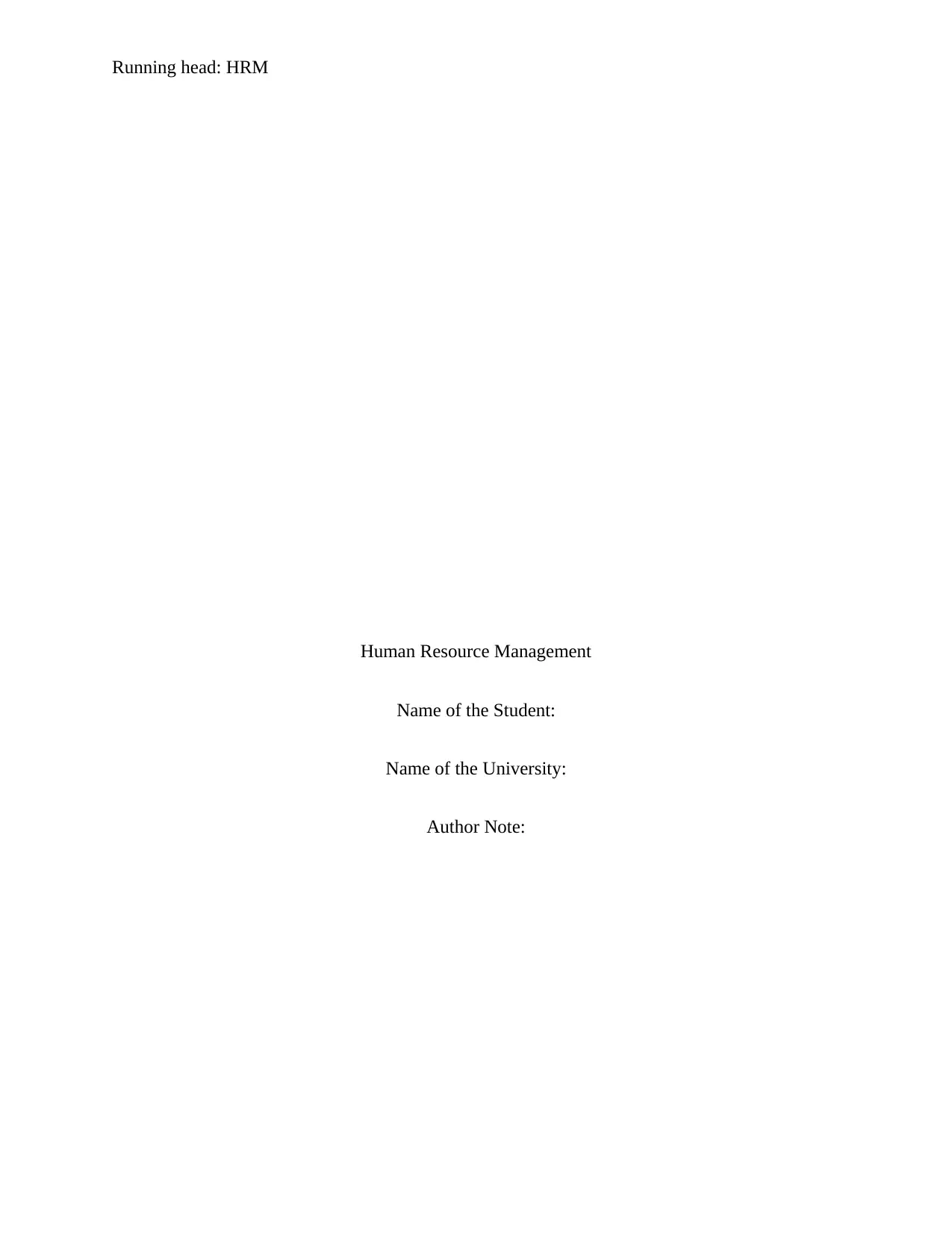
Running head: HRM
Human Resource Management
Name of the Student:
Name of the University:
Author Note:
Human Resource Management
Name of the Student:
Name of the University:
Author Note:
Paraphrase This Document
Need a fresh take? Get an instant paraphrase of this document with our AI Paraphraser
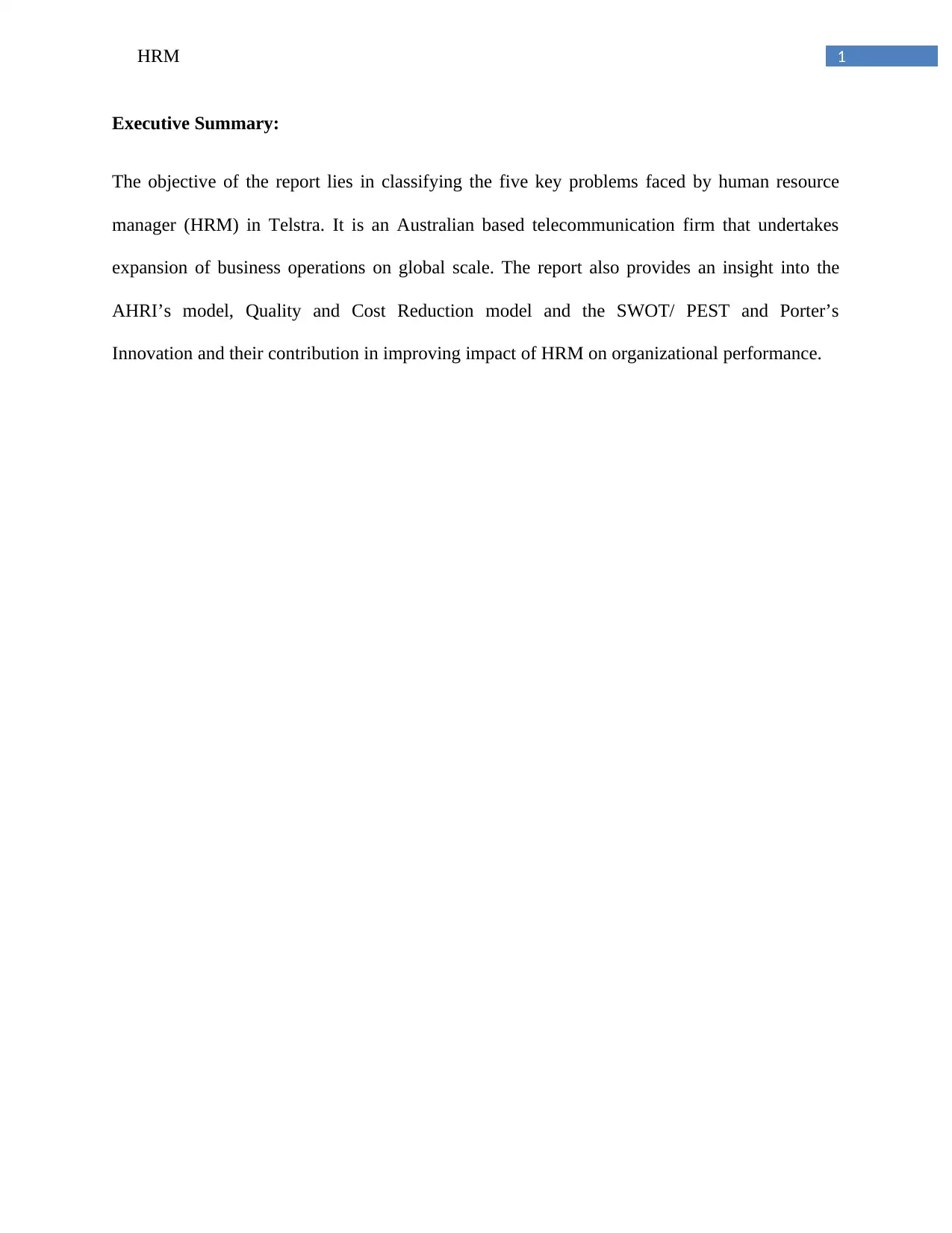
1HRM
Executive Summary:
The objective of the report lies in classifying the five key problems faced by human resource
manager (HRM) in Telstra. It is an Australian based telecommunication firm that undertakes
expansion of business operations on global scale. The report also provides an insight into the
AHRI’s model, Quality and Cost Reduction model and the SWOT/ PEST and Porter’s
Innovation and their contribution in improving impact of HRM on organizational performance.
Executive Summary:
The objective of the report lies in classifying the five key problems faced by human resource
manager (HRM) in Telstra. It is an Australian based telecommunication firm that undertakes
expansion of business operations on global scale. The report also provides an insight into the
AHRI’s model, Quality and Cost Reduction model and the SWOT/ PEST and Porter’s
Innovation and their contribution in improving impact of HRM on organizational performance.
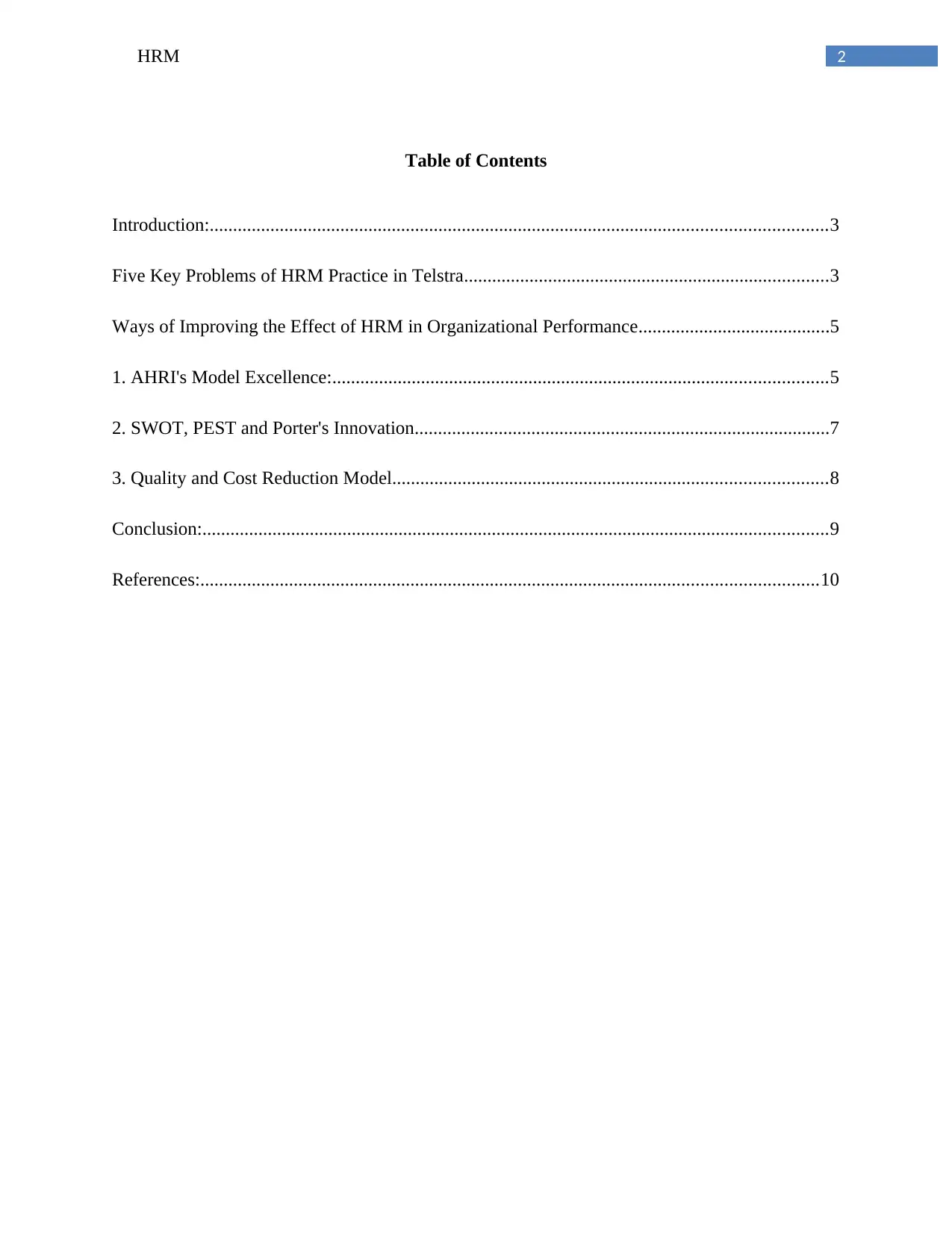
2HRM
Table of Contents
Introduction:....................................................................................................................................3
Five Key Problems of HRM Practice in Telstra..............................................................................3
Ways of Improving the Effect of HRM in Organizational Performance.........................................5
1. AHRI's Model Excellence:..........................................................................................................5
2. SWOT, PEST and Porter's Innovation.........................................................................................7
3. Quality and Cost Reduction Model.............................................................................................8
Conclusion:......................................................................................................................................9
References:....................................................................................................................................10
Table of Contents
Introduction:....................................................................................................................................3
Five Key Problems of HRM Practice in Telstra..............................................................................3
Ways of Improving the Effect of HRM in Organizational Performance.........................................5
1. AHRI's Model Excellence:..........................................................................................................5
2. SWOT, PEST and Porter's Innovation.........................................................................................7
3. Quality and Cost Reduction Model.............................................................................................8
Conclusion:......................................................................................................................................9
References:....................................................................................................................................10
⊘ This is a preview!⊘
Do you want full access?
Subscribe today to unlock all pages.

Trusted by 1+ million students worldwide
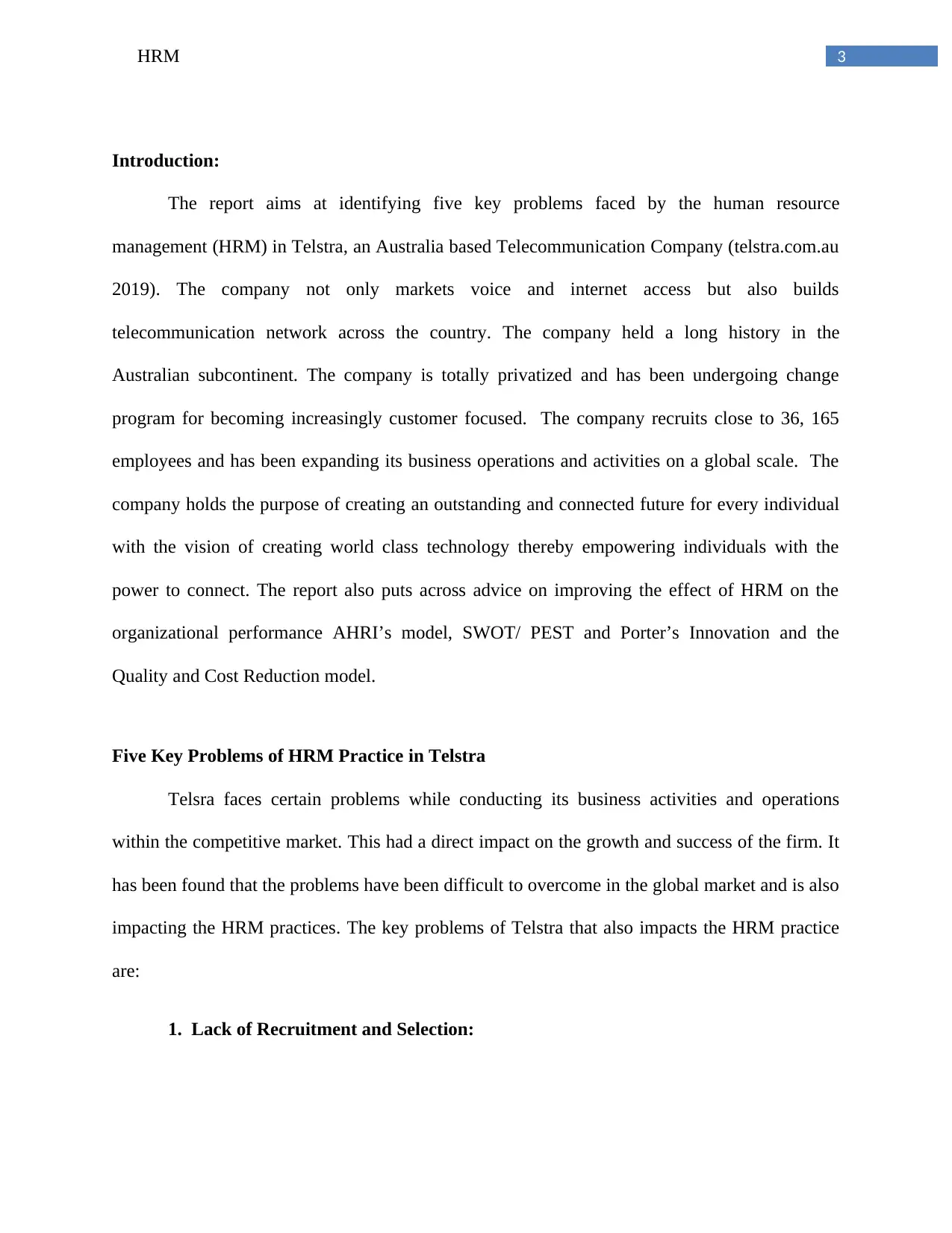
3HRM
Introduction:
The report aims at identifying five key problems faced by the human resource
management (HRM) in Telstra, an Australia based Telecommunication Company (telstra.com.au
2019). The company not only markets voice and internet access but also builds
telecommunication network across the country. The company held a long history in the
Australian subcontinent. The company is totally privatized and has been undergoing change
program for becoming increasingly customer focused. The company recruits close to 36, 165
employees and has been expanding its business operations and activities on a global scale. The
company holds the purpose of creating an outstanding and connected future for every individual
with the vision of creating world class technology thereby empowering individuals with the
power to connect. The report also puts across advice on improving the effect of HRM on the
organizational performance AHRI’s model, SWOT/ PEST and Porter’s Innovation and the
Quality and Cost Reduction model.
Five Key Problems of HRM Practice in Telstra
Telsra faces certain problems while conducting its business activities and operations
within the competitive market. This had a direct impact on the growth and success of the firm. It
has been found that the problems have been difficult to overcome in the global market and is also
impacting the HRM practices. The key problems of Telstra that also impacts the HRM practice
are:
1. Lack of Recruitment and Selection:
Introduction:
The report aims at identifying five key problems faced by the human resource
management (HRM) in Telstra, an Australia based Telecommunication Company (telstra.com.au
2019). The company not only markets voice and internet access but also builds
telecommunication network across the country. The company held a long history in the
Australian subcontinent. The company is totally privatized and has been undergoing change
program for becoming increasingly customer focused. The company recruits close to 36, 165
employees and has been expanding its business operations and activities on a global scale. The
company holds the purpose of creating an outstanding and connected future for every individual
with the vision of creating world class technology thereby empowering individuals with the
power to connect. The report also puts across advice on improving the effect of HRM on the
organizational performance AHRI’s model, SWOT/ PEST and Porter’s Innovation and the
Quality and Cost Reduction model.
Five Key Problems of HRM Practice in Telstra
Telsra faces certain problems while conducting its business activities and operations
within the competitive market. This had a direct impact on the growth and success of the firm. It
has been found that the problems have been difficult to overcome in the global market and is also
impacting the HRM practices. The key problems of Telstra that also impacts the HRM practice
are:
1. Lack of Recruitment and Selection:
Paraphrase This Document
Need a fresh take? Get an instant paraphrase of this document with our AI Paraphraser
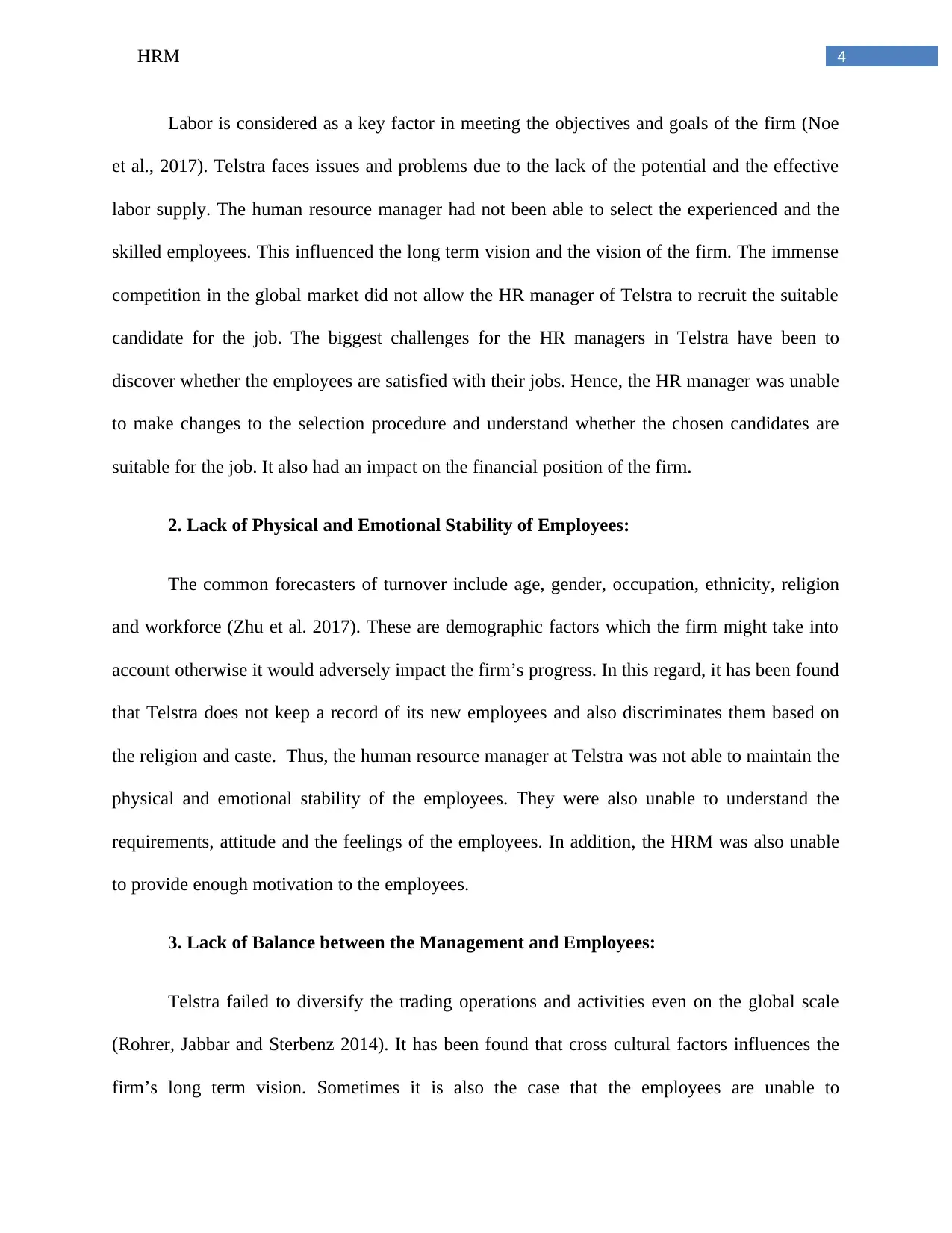
4HRM
Labor is considered as a key factor in meeting the objectives and goals of the firm (Noe
et al., 2017). Telstra faces issues and problems due to the lack of the potential and the effective
labor supply. The human resource manager had not been able to select the experienced and the
skilled employees. This influenced the long term vision and the vision of the firm. The immense
competition in the global market did not allow the HR manager of Telstra to recruit the suitable
candidate for the job. The biggest challenges for the HR managers in Telstra have been to
discover whether the employees are satisfied with their jobs. Hence, the HR manager was unable
to make changes to the selection procedure and understand whether the chosen candidates are
suitable for the job. It also had an impact on the financial position of the firm.
2. Lack of Physical and Emotional Stability of Employees:
The common forecasters of turnover include age, gender, occupation, ethnicity, religion
and workforce (Zhu et al. 2017). These are demographic factors which the firm might take into
account otherwise it would adversely impact the firm’s progress. In this regard, it has been found
that Telstra does not keep a record of its new employees and also discriminates them based on
the religion and caste. Thus, the human resource manager at Telstra was not able to maintain the
physical and emotional stability of the employees. They were also unable to understand the
requirements, attitude and the feelings of the employees. In addition, the HRM was also unable
to provide enough motivation to the employees.
3. Lack of Balance between the Management and Employees:
Telstra failed to diversify the trading operations and activities even on the global scale
(Rohrer, Jabbar and Sterbenz 2014). It has been found that cross cultural factors influences the
firm’s long term vision. Sometimes it is also the case that the employees are unable to
Labor is considered as a key factor in meeting the objectives and goals of the firm (Noe
et al., 2017). Telstra faces issues and problems due to the lack of the potential and the effective
labor supply. The human resource manager had not been able to select the experienced and the
skilled employees. This influenced the long term vision and the vision of the firm. The immense
competition in the global market did not allow the HR manager of Telstra to recruit the suitable
candidate for the job. The biggest challenges for the HR managers in Telstra have been to
discover whether the employees are satisfied with their jobs. Hence, the HR manager was unable
to make changes to the selection procedure and understand whether the chosen candidates are
suitable for the job. It also had an impact on the financial position of the firm.
2. Lack of Physical and Emotional Stability of Employees:
The common forecasters of turnover include age, gender, occupation, ethnicity, religion
and workforce (Zhu et al. 2017). These are demographic factors which the firm might take into
account otherwise it would adversely impact the firm’s progress. In this regard, it has been found
that Telstra does not keep a record of its new employees and also discriminates them based on
the religion and caste. Thus, the human resource manager at Telstra was not able to maintain the
physical and emotional stability of the employees. They were also unable to understand the
requirements, attitude and the feelings of the employees. In addition, the HRM was also unable
to provide enough motivation to the employees.
3. Lack of Balance between the Management and Employees:
Telstra failed to diversify the trading operations and activities even on the global scale
(Rohrer, Jabbar and Sterbenz 2014). It has been found that cross cultural factors influences the
firm’s long term vision. Sometimes it is also the case that the employees are unable to
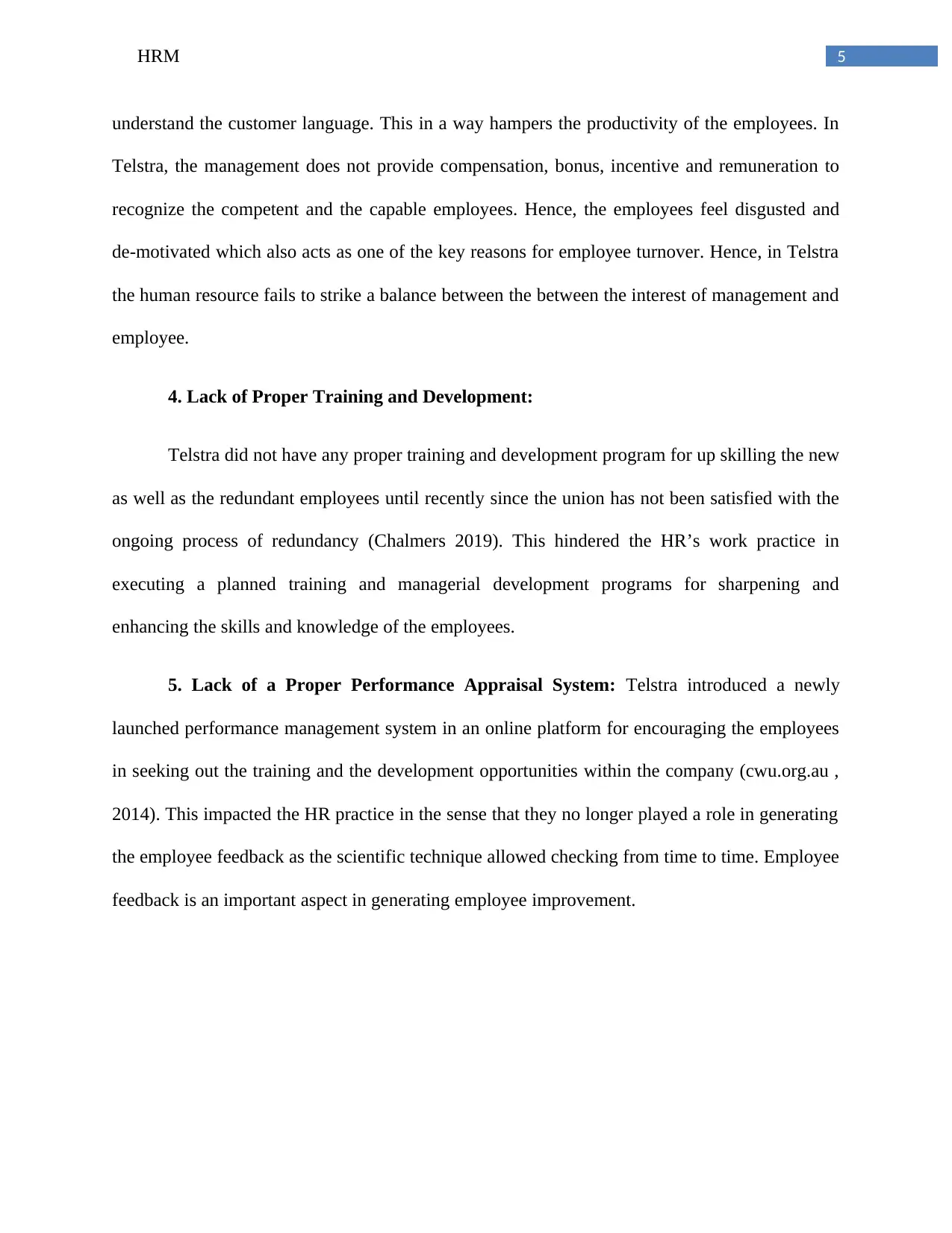
5HRM
understand the customer language. This in a way hampers the productivity of the employees. In
Telstra, the management does not provide compensation, bonus, incentive and remuneration to
recognize the competent and the capable employees. Hence, the employees feel disgusted and
de-motivated which also acts as one of the key reasons for employee turnover. Hence, in Telstra
the human resource fails to strike a balance between the between the interest of management and
employee.
4. Lack of Proper Training and Development:
Telstra did not have any proper training and development program for up skilling the new
as well as the redundant employees until recently since the union has not been satisfied with the
ongoing process of redundancy (Chalmers 2019). This hindered the HR’s work practice in
executing a planned training and managerial development programs for sharpening and
enhancing the skills and knowledge of the employees.
5. Lack of a Proper Performance Appraisal System: Telstra introduced a newly
launched performance management system in an online platform for encouraging the employees
in seeking out the training and the development opportunities within the company (cwu.org.au ,
2014). This impacted the HR practice in the sense that they no longer played a role in generating
the employee feedback as the scientific technique allowed checking from time to time. Employee
feedback is an important aspect in generating employee improvement.
understand the customer language. This in a way hampers the productivity of the employees. In
Telstra, the management does not provide compensation, bonus, incentive and remuneration to
recognize the competent and the capable employees. Hence, the employees feel disgusted and
de-motivated which also acts as one of the key reasons for employee turnover. Hence, in Telstra
the human resource fails to strike a balance between the between the interest of management and
employee.
4. Lack of Proper Training and Development:
Telstra did not have any proper training and development program for up skilling the new
as well as the redundant employees until recently since the union has not been satisfied with the
ongoing process of redundancy (Chalmers 2019). This hindered the HR’s work practice in
executing a planned training and managerial development programs for sharpening and
enhancing the skills and knowledge of the employees.
5. Lack of a Proper Performance Appraisal System: Telstra introduced a newly
launched performance management system in an online platform for encouraging the employees
in seeking out the training and the development opportunities within the company (cwu.org.au ,
2014). This impacted the HR practice in the sense that they no longer played a role in generating
the employee feedback as the scientific technique allowed checking from time to time. Employee
feedback is an important aspect in generating employee improvement.
⊘ This is a preview!⊘
Do you want full access?
Subscribe today to unlock all pages.

Trusted by 1+ million students worldwide
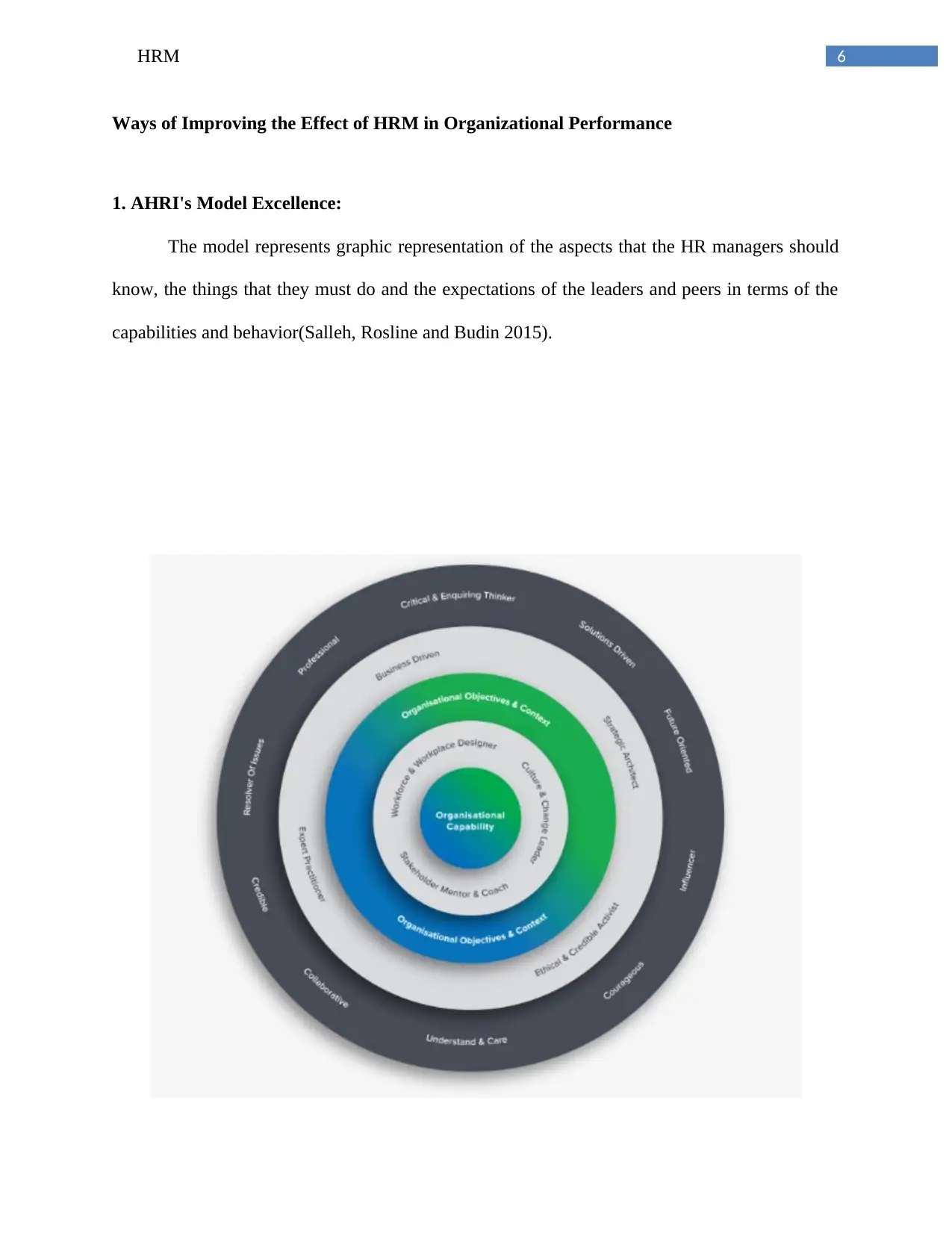
6HRM
Ways of Improving the Effect of HRM in Organizational Performance
1. AHRI's Model Excellence:
The model represents graphic representation of the aspects that the HR managers should
know, the things that they must do and the expectations of the leaders and peers in terms of the
capabilities and behavior(Salleh, Rosline and Budin 2015).
Ways of Improving the Effect of HRM in Organizational Performance
1. AHRI's Model Excellence:
The model represents graphic representation of the aspects that the HR managers should
know, the things that they must do and the expectations of the leaders and peers in terms of the
capabilities and behavior(Salleh, Rosline and Budin 2015).
Paraphrase This Document
Need a fresh take? Get an instant paraphrase of this document with our AI Paraphraser
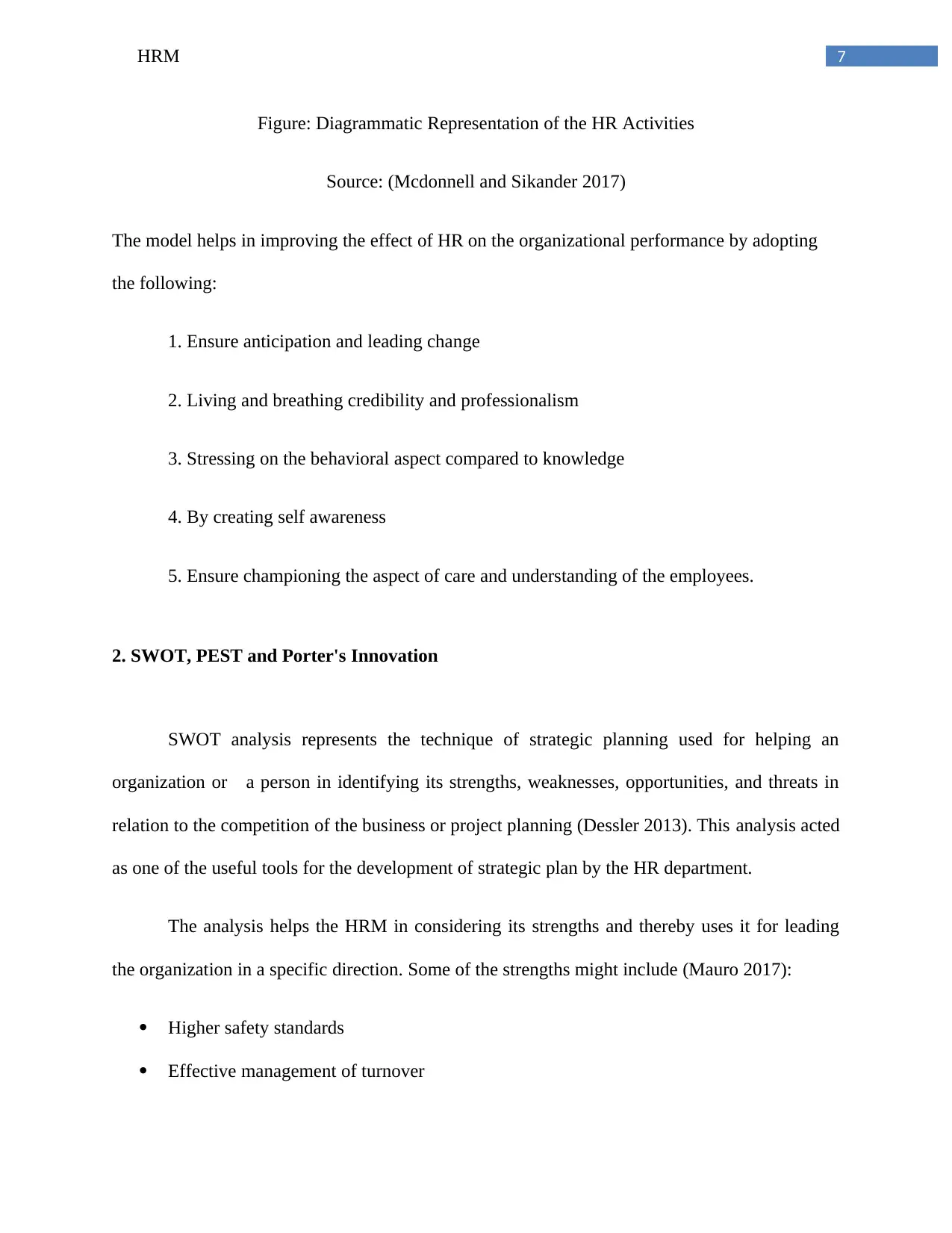
7HRM
Figure: Diagrammatic Representation of the HR Activities
Source: (Mcdonnell and Sikander 2017)
The model helps in improving the effect of HR on the organizational performance by adopting
the following:
1. Ensure anticipation and leading change
2. Living and breathing credibility and professionalism
3. Stressing on the behavioral aspect compared to knowledge
4. By creating self awareness
5. Ensure championing the aspect of care and understanding of the employees.
2. SWOT, PEST and Porter's Innovation
SWOT analysis represents the technique of strategic planning used for helping an
organization or a person in identifying its strengths, weaknesses, opportunities, and threats in
relation to the competition of the business or project planning (Dessler 2013). This analysis acted
as one of the useful tools for the development of strategic plan by the HR department.
The analysis helps the HRM in considering its strengths and thereby uses it for leading
the organization in a specific direction. Some of the strengths might include (Mauro 2017):
Higher safety standards
Effective management of turnover
Figure: Diagrammatic Representation of the HR Activities
Source: (Mcdonnell and Sikander 2017)
The model helps in improving the effect of HR on the organizational performance by adopting
the following:
1. Ensure anticipation and leading change
2. Living and breathing credibility and professionalism
3. Stressing on the behavioral aspect compared to knowledge
4. By creating self awareness
5. Ensure championing the aspect of care and understanding of the employees.
2. SWOT, PEST and Porter's Innovation
SWOT analysis represents the technique of strategic planning used for helping an
organization or a person in identifying its strengths, weaknesses, opportunities, and threats in
relation to the competition of the business or project planning (Dessler 2013). This analysis acted
as one of the useful tools for the development of strategic plan by the HR department.
The analysis helps the HRM in considering its strengths and thereby uses it for leading
the organization in a specific direction. Some of the strengths might include (Mauro 2017):
Higher safety standards
Effective management of turnover
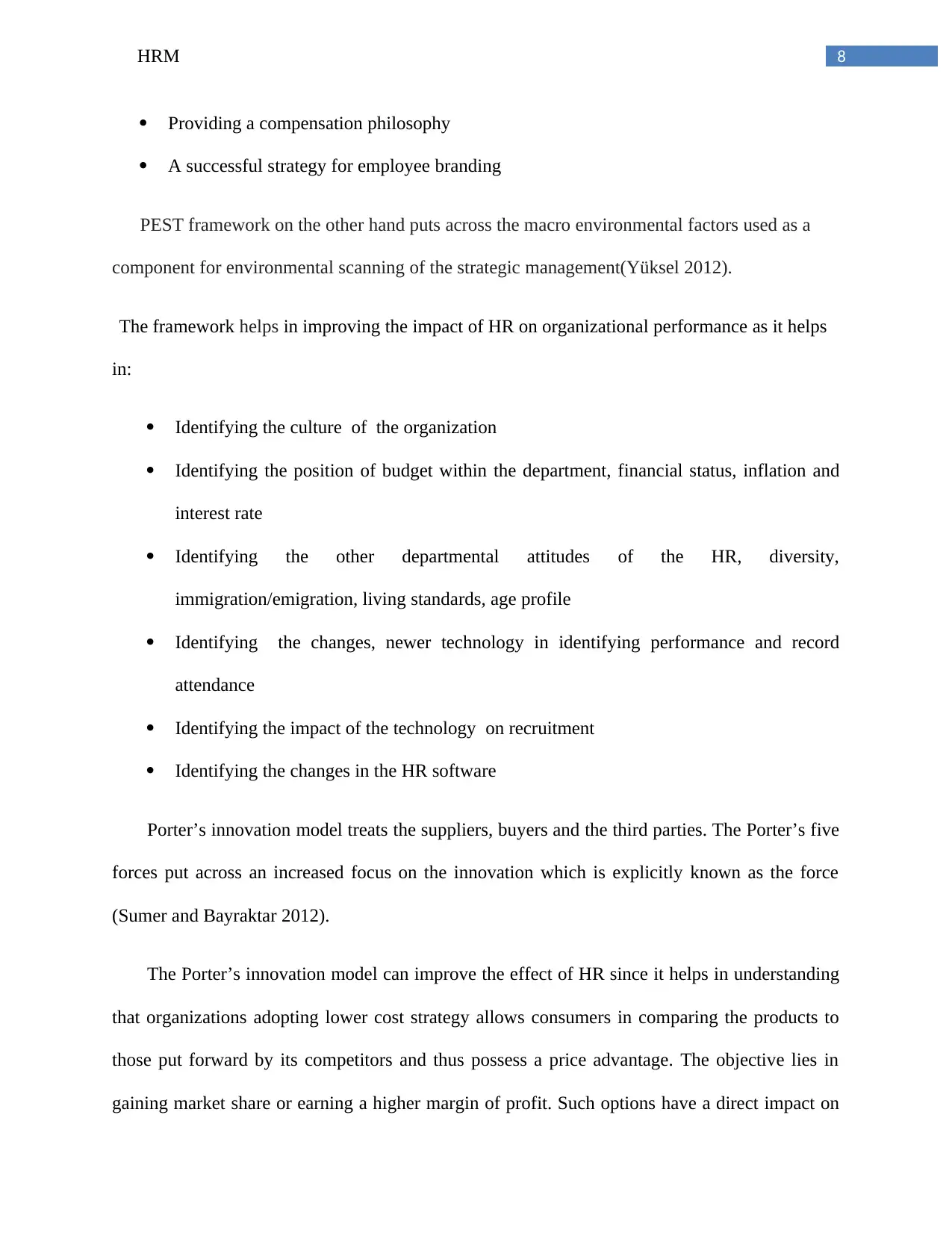
8HRM
Providing a compensation philosophy
A successful strategy for employee branding
PEST framework on the other hand puts across the macro environmental factors used as a
component for environmental scanning of the strategic management(Yüksel 2012).
The framework helps in improving the impact of HR on organizational performance as it helps
in:
Identifying the culture of the organization
Identifying the position of budget within the department, financial status, inflation and
interest rate
Identifying the other departmental attitudes of the HR, diversity,
immigration/emigration, living standards, age profile
Identifying the changes, newer technology in identifying performance and record
attendance
Identifying the impact of the technology on recruitment
Identifying the changes in the HR software
Porter’s innovation model treats the suppliers, buyers and the third parties. The Porter’s five
forces put across an increased focus on the innovation which is explicitly known as the force
(Sumer and Bayraktar 2012).
The Porter’s innovation model can improve the effect of HR since it helps in understanding
that organizations adopting lower cost strategy allows consumers in comparing the products to
those put forward by its competitors and thus possess a price advantage. The objective lies in
gaining market share or earning a higher margin of profit. Such options have a direct impact on
Providing a compensation philosophy
A successful strategy for employee branding
PEST framework on the other hand puts across the macro environmental factors used as a
component for environmental scanning of the strategic management(Yüksel 2012).
The framework helps in improving the impact of HR on organizational performance as it helps
in:
Identifying the culture of the organization
Identifying the position of budget within the department, financial status, inflation and
interest rate
Identifying the other departmental attitudes of the HR, diversity,
immigration/emigration, living standards, age profile
Identifying the changes, newer technology in identifying performance and record
attendance
Identifying the impact of the technology on recruitment
Identifying the changes in the HR software
Porter’s innovation model treats the suppliers, buyers and the third parties. The Porter’s five
forces put across an increased focus on the innovation which is explicitly known as the force
(Sumer and Bayraktar 2012).
The Porter’s innovation model can improve the effect of HR since it helps in understanding
that organizations adopting lower cost strategy allows consumers in comparing the products to
those put forward by its competitors and thus possess a price advantage. The objective lies in
gaining market share or earning a higher margin of profit. Such options have a direct impact on
⊘ This is a preview!⊘
Do you want full access?
Subscribe today to unlock all pages.

Trusted by 1+ million students worldwide
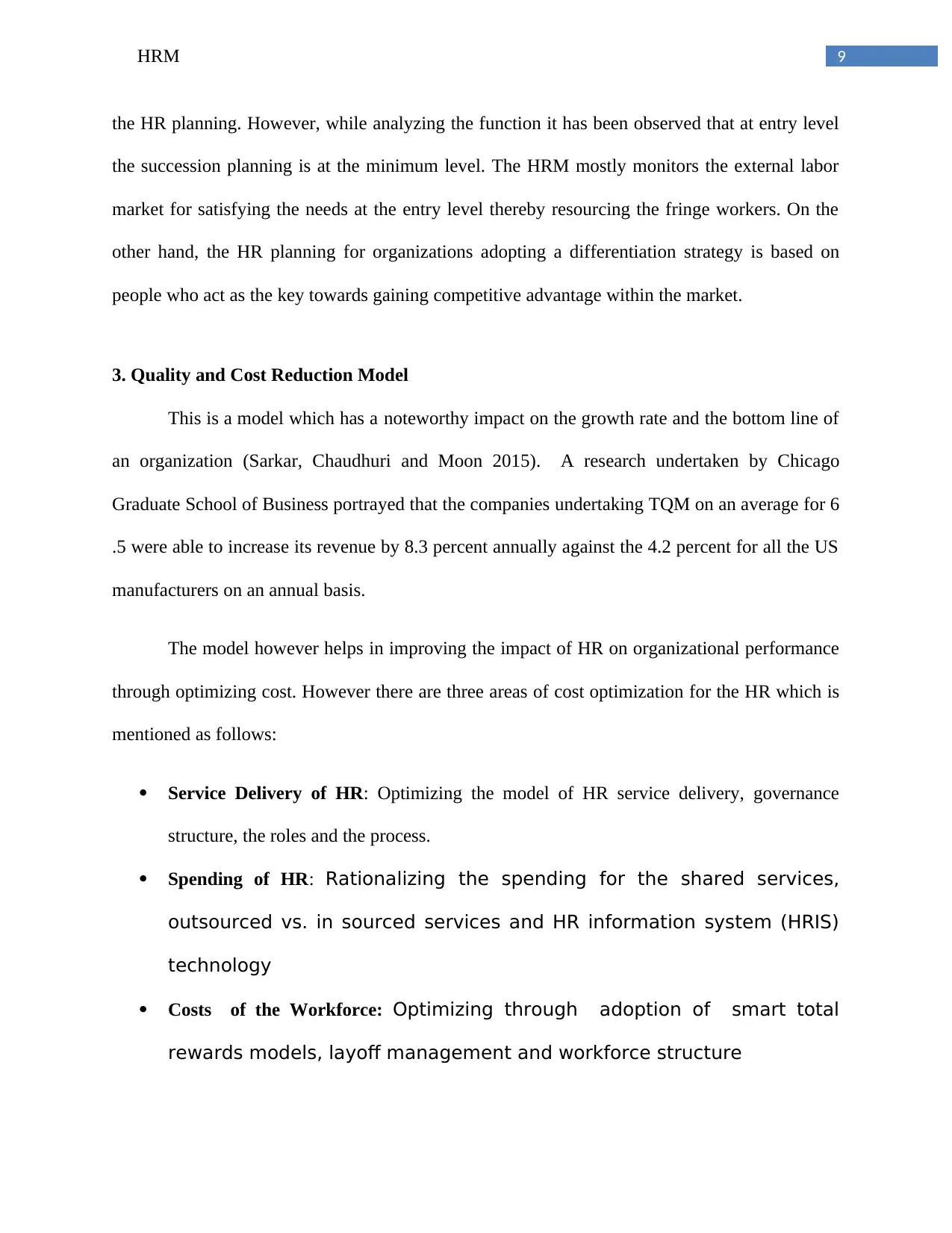
9HRM
the HR planning. However, while analyzing the function it has been observed that at entry level
the succession planning is at the minimum level. The HRM mostly monitors the external labor
market for satisfying the needs at the entry level thereby resourcing the fringe workers. On the
other hand, the HR planning for organizations adopting a differentiation strategy is based on
people who act as the key towards gaining competitive advantage within the market.
3. Quality and Cost Reduction Model
This is a model which has a noteworthy impact on the growth rate and the bottom line of
an organization (Sarkar, Chaudhuri and Moon 2015). A research undertaken by Chicago
Graduate School of Business portrayed that the companies undertaking TQM on an average for 6
.5 were able to increase its revenue by 8.3 percent annually against the 4.2 percent for all the US
manufacturers on an annual basis.
The model however helps in improving the impact of HR on organizational performance
through optimizing cost. However there are three areas of cost optimization for the HR which is
mentioned as follows:
Service Delivery of HR: Optimizing the model of HR service delivery, governance
structure, the roles and the process.
Spending of HR: Rationalizing the spending for the shared services,
outsourced vs. in sourced services and HR information system (HRIS)
technology
Costs of the Workforce: Optimizing through adoption of smart total
rewards models, layoff management and workforce structure
the HR planning. However, while analyzing the function it has been observed that at entry level
the succession planning is at the minimum level. The HRM mostly monitors the external labor
market for satisfying the needs at the entry level thereby resourcing the fringe workers. On the
other hand, the HR planning for organizations adopting a differentiation strategy is based on
people who act as the key towards gaining competitive advantage within the market.
3. Quality and Cost Reduction Model
This is a model which has a noteworthy impact on the growth rate and the bottom line of
an organization (Sarkar, Chaudhuri and Moon 2015). A research undertaken by Chicago
Graduate School of Business portrayed that the companies undertaking TQM on an average for 6
.5 were able to increase its revenue by 8.3 percent annually against the 4.2 percent for all the US
manufacturers on an annual basis.
The model however helps in improving the impact of HR on organizational performance
through optimizing cost. However there are three areas of cost optimization for the HR which is
mentioned as follows:
Service Delivery of HR: Optimizing the model of HR service delivery, governance
structure, the roles and the process.
Spending of HR: Rationalizing the spending for the shared services,
outsourced vs. in sourced services and HR information system (HRIS)
technology
Costs of the Workforce: Optimizing through adoption of smart total
rewards models, layoff management and workforce structure
Paraphrase This Document
Need a fresh take? Get an instant paraphrase of this document with our AI Paraphraser
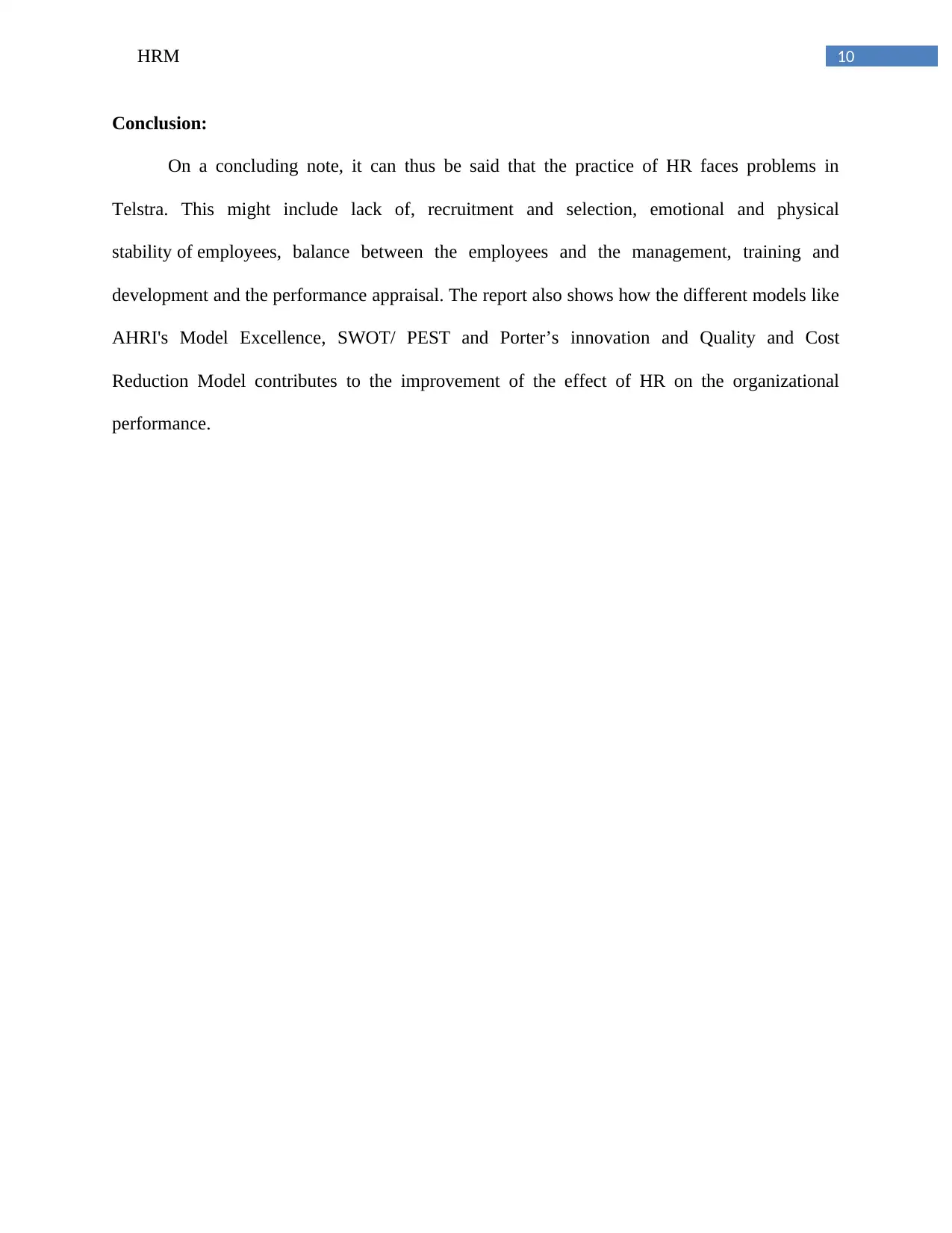
10HRM
Conclusion:
On a concluding note, it can thus be said that the practice of HR faces problems in
Telstra. This might include lack of, recruitment and selection, emotional and physical
stability of employees, balance between the employees and the management, training and
development and the performance appraisal. The report also shows how the different models like
AHRI's Model Excellence, SWOT/ PEST and Porter’s innovation and Quality and Cost
Reduction Model contributes to the improvement of the effect of HR on the organizational
performance.
Conclusion:
On a concluding note, it can thus be said that the practice of HR faces problems in
Telstra. This might include lack of, recruitment and selection, emotional and physical
stability of employees, balance between the employees and the management, training and
development and the performance appraisal. The report also shows how the different models like
AHRI's Model Excellence, SWOT/ PEST and Porter’s innovation and Quality and Cost
Reduction Model contributes to the improvement of the effect of HR on the organizational
performance.
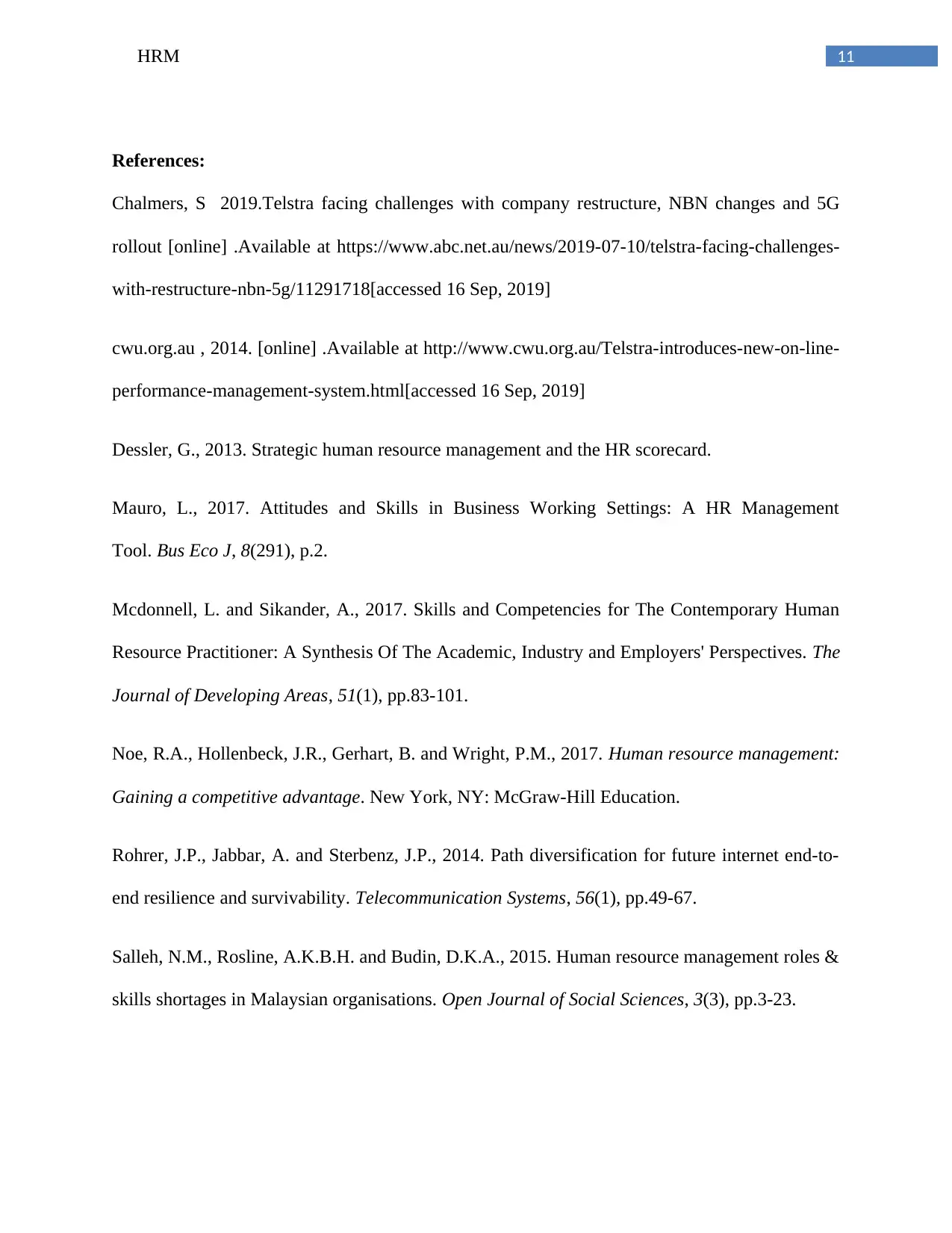
11HRM
References:
Chalmers, S 2019.Telstra facing challenges with company restructure, NBN changes and 5G
rollout [online] .Available at https://www.abc.net.au/news/2019-07-10/telstra-facing-challenges-
with-restructure-nbn-5g/11291718[accessed 16 Sep, 2019]
cwu.org.au , 2014. [online] .Available at http://www.cwu.org.au/Telstra-introduces-new-on-line-
performance-management-system.html[accessed 16 Sep, 2019]
Dessler, G., 2013. Strategic human resource management and the HR scorecard.
Mauro, L., 2017. Attitudes and Skills in Business Working Settings: A HR Management
Tool. Bus Eco J, 8(291), p.2.
Mcdonnell, L. and Sikander, A., 2017. Skills and Competencies for The Contemporary Human
Resource Practitioner: A Synthesis Of The Academic, Industry and Employers' Perspectives. The
Journal of Developing Areas, 51(1), pp.83-101.
Noe, R.A., Hollenbeck, J.R., Gerhart, B. and Wright, P.M., 2017. Human resource management:
Gaining a competitive advantage. New York, NY: McGraw-Hill Education.
Rohrer, J.P., Jabbar, A. and Sterbenz, J.P., 2014. Path diversification for future internet end-to-
end resilience and survivability. Telecommunication Systems, 56(1), pp.49-67.
Salleh, N.M., Rosline, A.K.B.H. and Budin, D.K.A., 2015. Human resource management roles &
skills shortages in Malaysian organisations. Open Journal of Social Sciences, 3(3), pp.3-23.
References:
Chalmers, S 2019.Telstra facing challenges with company restructure, NBN changes and 5G
rollout [online] .Available at https://www.abc.net.au/news/2019-07-10/telstra-facing-challenges-
with-restructure-nbn-5g/11291718[accessed 16 Sep, 2019]
cwu.org.au , 2014. [online] .Available at http://www.cwu.org.au/Telstra-introduces-new-on-line-
performance-management-system.html[accessed 16 Sep, 2019]
Dessler, G., 2013. Strategic human resource management and the HR scorecard.
Mauro, L., 2017. Attitudes and Skills in Business Working Settings: A HR Management
Tool. Bus Eco J, 8(291), p.2.
Mcdonnell, L. and Sikander, A., 2017. Skills and Competencies for The Contemporary Human
Resource Practitioner: A Synthesis Of The Academic, Industry and Employers' Perspectives. The
Journal of Developing Areas, 51(1), pp.83-101.
Noe, R.A., Hollenbeck, J.R., Gerhart, B. and Wright, P.M., 2017. Human resource management:
Gaining a competitive advantage. New York, NY: McGraw-Hill Education.
Rohrer, J.P., Jabbar, A. and Sterbenz, J.P., 2014. Path diversification for future internet end-to-
end resilience and survivability. Telecommunication Systems, 56(1), pp.49-67.
Salleh, N.M., Rosline, A.K.B.H. and Budin, D.K.A., 2015. Human resource management roles &
skills shortages in Malaysian organisations. Open Journal of Social Sciences, 3(3), pp.3-23.
⊘ This is a preview!⊘
Do you want full access?
Subscribe today to unlock all pages.

Trusted by 1+ million students worldwide
1 out of 13
Related Documents
Your All-in-One AI-Powered Toolkit for Academic Success.
+13062052269
info@desklib.com
Available 24*7 on WhatsApp / Email
![[object Object]](/_next/static/media/star-bottom.7253800d.svg)
Unlock your academic potential
Copyright © 2020–2025 A2Z Services. All Rights Reserved. Developed and managed by ZUCOL.




